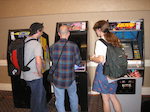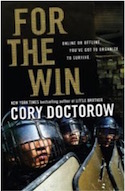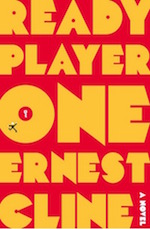by Jeanne Henry, Hofstra University; Tonia Asare-Smith, Dreamweaver House, & Hofstra University; Tashema Spence, Pathways to Graduation, NYCDOE, & Hofstra University
 To an outsider, the appeal of gaming can be baffling, at best and, at worst, non-gamers, especially of the adult variety, can be quick to judge the character of button-mashing game devotees. But two YA books that go a long way in illustrating the considerable depth and dimension to video game play are Cory Doctorow’s For the Win (2010) and Ernest Cline’s Ready Player One (2011), both of which reveal the emotional involvement of game play—the thrill, if you will—as well as the ways in which games can offer a reprieve from the routine, an escape from the grind, and a place in which to explore identity: villain/champion, boy/girl.
To an outsider, the appeal of gaming can be baffling, at best and, at worst, non-gamers, especially of the adult variety, can be quick to judge the character of button-mashing game devotees. But two YA books that go a long way in illustrating the considerable depth and dimension to video game play are Cory Doctorow’s For the Win (2010) and Ernest Cline’s Ready Player One (2011), both of which reveal the emotional involvement of game play—the thrill, if you will—as well as the ways in which games can offer a reprieve from the routine, an escape from the grind, and a place in which to explore identity: villain/champion, boy/girl.
 Just to touch on the plot, For the Win (Doctorow, 2010) brings together a number of characters from around the world whose commonality is playing Massively Multiplayer Online Role Playing Games (MMORPGS). While some in the Western world play for fun, Matthew in China, and Yasmin in India, are “gold farmers” who work long shifts in internet cafes playing for game “gold,” which their bosses sell to lazy players who want to level up (improve their skills) by buying superior game gear (weapons, armor, spells) without actually taking the time to do so themselves. This reality inspires other gamers in the novel to become activists advocating for improved working conditions for online workers.
Just to touch on the plot, For the Win (Doctorow, 2010) brings together a number of characters from around the world whose commonality is playing Massively Multiplayer Online Role Playing Games (MMORPGS). While some in the Western world play for fun, Matthew in China, and Yasmin in India, are “gold farmers” who work long shifts in internet cafes playing for game “gold,” which their bosses sell to lazy players who want to level up (improve their skills) by buying superior game gear (weapons, armor, spells) without actually taking the time to do so themselves. This reality inspires other gamers in the novel to become activists advocating for improved working conditions for online workers.
Doctorow’s novels balance excitement and didacticism, but when he writes from a gamer’s point of view, he puts readers inside the games his characters love to play. As Tonia Asare-Smith notes, “the perception of the lines between physical reality and virtual reality [in video games] become blurred.” For gamers, virtual reality has a real advantage over the monotony of their often over-scheduled lives, and gaming teens want to punctuate their days with moments of heroism and camaraderie. In Reality is Broken (2010), Jane McGonigal observes “the freedom to enter or leave a game at will ensures that intentionally stressful and challenging work [such as waging war] is experienced as a safe and pleasurable activity” (Chapter 1, Section 2, para. 9). Although games may be perceived as passive and vacuous activities, For the Win (2010) suggests that playing a video game is a way to break up the routine of our days and to make paragons (or union organizers) of even the most ordinary among us. Everybody needs to slay a dragon now and then.
 Tonia Asare-Smith and Tashema Spence both point out the ways in which Ernest Clines’s Ready Player One (2011) presents a game world not as a time-out from an ordinary reality but a respite from a broken one. The novel is set in 2044 and the protagonist, Wade Watts, escapes into the OASIS, a virtual world that Tonia Asare-Smith explains is an appealing alternative “to climate change, poverty, continuous unemployment, and economic stresses in the world.” She continues “[Wade] uses the utopia OASIS to keep himself sane.” Tashema Spence identifies the therapeutic aspects of gaming for Wade:
Tonia Asare-Smith and Tashema Spence both point out the ways in which Ernest Clines’s Ready Player One (2011) presents a game world not as a time-out from an ordinary reality but a respite from a broken one. The novel is set in 2044 and the protagonist, Wade Watts, escapes into the OASIS, a virtual world that Tonia Asare-Smith explains is an appealing alternative “to climate change, poverty, continuous unemployment, and economic stresses in the world.” She continues “[Wade] uses the utopia OASIS to keep himself sane.” Tashema Spence identifies the therapeutic aspects of gaming for Wade:
Playing old video games never failed to clear my mind and set me at ease. If I was feeling depressed or frustrated about my lot in life, all I have to do was tap the Player One button, and my worries would instantly slip away as my mind focused itself on the relentless pixelated onslaught on the screen in front of me. There inside the game’s two-dimensional universe, life was simple (Cline, 2011, p. 21)
When the originator of OASIS dies, his legacy will pass to the player who wins an epic, 80s-based game he has created to find a worthy heir. Wade, and a handful of allies, play against and with, each other, but the villain of the novel, and the threat to the idyll of OASIS, is Innovative Online Industries (IOI), a corporate menace that, if allowed to win the game, will win control of OASIS, resulting in “a corporate-run dystopia, an overpriced theme park for wealthy elitists” (Cline, 2011, p. 33).
Tashema Spence’s writing for the class focuses quite a bit on the ways games offer players an opportunity to experiment with identity. She points out that games often begin with the need to create an avatar that represents the player in the virtual world. And she suggests that Cline’s (2011) characters “feel much safer and accepted with their online identity and within online communities than they do offline.” She highlights this contrast with a passage from Ready Player One (2011), in which Wade describes his offline self as a “painfully shy, awkward kid, with low self-esteem and almost no social skills” (Cline, 2011, p.40) but as Spence adds, “online he has no problem talking to people or making friends.” Later, Wade describes designing his avatar, Parzival:
to look, more or less, like my own. My avatar had a slightly smaller nose than me, and he was taller. And thinner. And more muscular. And he didn’t have any teenage acne. But aside from these minor details, we looked more or less identical. (Cline, 2011, p. 27-28)
Spence concludes, “this relatable character shows that identity development and acceptance is an issue that teens are still grappling with, even in networked spaces. The anonymity provided by their online identity gives them the freedom and acceptance they crave.”
Tonia Asare-Smith made a particularly astute observation about the intersections of race, gender and sexuality in these YA novels. In a reveal near the end of Ready Player One (2011) (spoiler alert but it’s worth it) Wade learns that his best friend, Aech, whose avatar is that of “a tall, broad-shouldered Caucasian male with dark hair and brown eyes” (p.38) is, in real life a young African-American lesbian named Helen. While many gamers eagerly embrace the opportunity to play in and out of categories like gender and race, based simply on how they want to be perceived, Aech explains that her African-American mother had taught her the necessity of being perceived as a white male online in order to be well-treated. As Asare-Smith writes, “in Cline’s (2011) point of view, thirty years from now, there will still be racial prejudices and blacks will still not be entirely involved with networked publics such as MMOs (massively multiplayer online games).” Whereas Cline’s (2011) perception of the longitudinal effects of systemic racism is based on our current reality, Asare-Smith notes that this is a missed opportunity “which, unfortunately, leaves African American characters back in the late 20th Century.” In Reader Player One (2011), as well as in the other novels we read for the class, there were no other discernibly black or African-American characters. ** It is crucial that YA writers recognize that African-American teens are already deeply involved in gaming, social networking, and living networked lives, and that continued failure to depict these teens as technology users may deepen the digital divide.
References
Cline, E. (2011). Ready player one. New York: Crown.
Doctorow, C. (2010). For the win. New York: Tor Teen.
McGonigal, J. (2011). Reality is broken: Why games make us better and how they can change the world [Kindle version]. Retrieved from amazon.com
* Please see Eric Zimmerman’s Manifesto for a Ludic Century for our inspiration for the title.
** A tech-savvy African-American teen is a minor character in Josh Berk’s The Dark Days of Hamburger Halpin (2010), which we review in the last blog post of this series of entries, but we didn’t read the novel for the class.
Journey through Worlds of Words during our open reading hours: Monday-Friday, 9 a.m. to 5 p.m. and Saturday, 9 a.m. to 1 p.m. To view our complete offerings of WOW Currents, please visit archival stream.
- Themes: Jeanne Henry, Tashema Spence, Tonia Asare-Smith
- Descriptors: Books & Resources, WOW Currents
